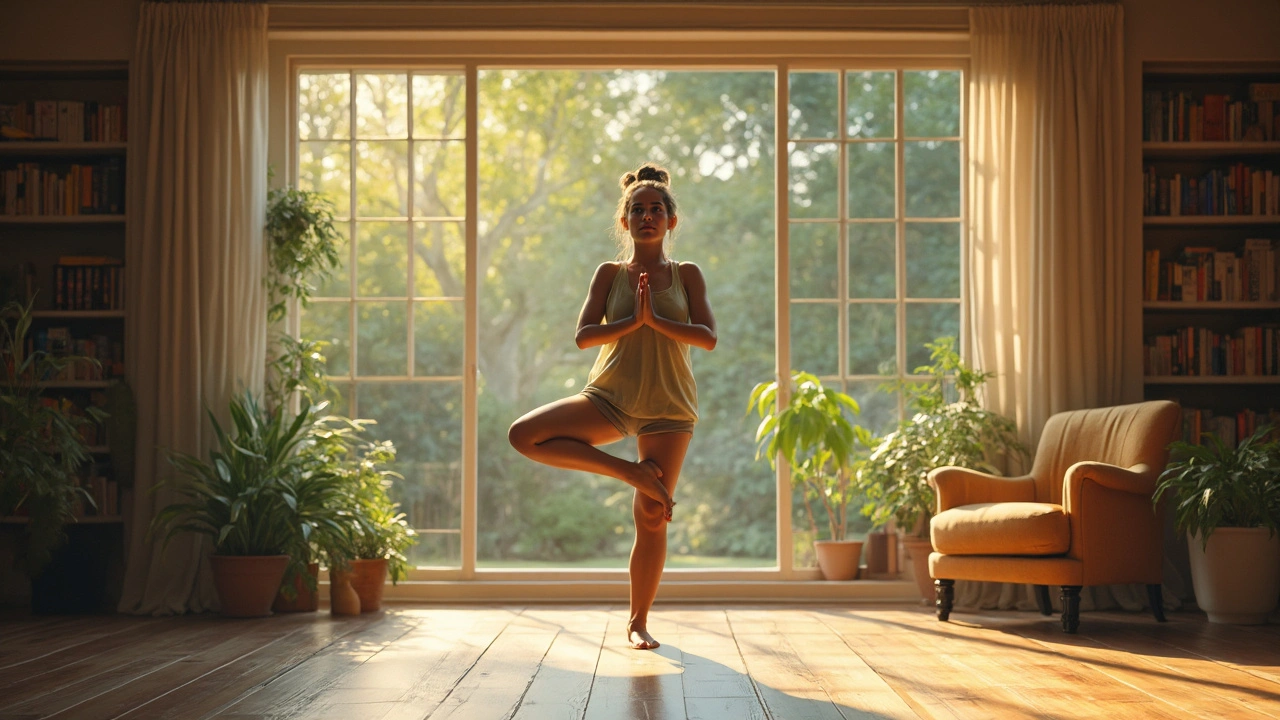Dizziness might feel like a pesky mystery, throwing us off balance at the most inconvenient times. But did you know that yoga and meditation could be your sidekicks in tackling it naturally? Yep, no prescriptions needed here.
Let's break it down: Yoga is like a genius combo of movement and mindfulness, designed to enhance balance. When your body knows how to balance itself, those dizzy spirals can find their way out the door. Plus, regular yoga practice lowers stress, a known culprit in dizziness.
And then there's meditation. Picture it as pressing the reset button on your brain. It calms the mind, sharpens focus, and guess what? A clear head might just mean less spinning around in confusion. Later, we'll explore simple yoga poses and meditation techniques to try at home. Easy and effective steps, one at a time!
- Understanding Dizziness
- Why Yoga Works
- How Meditation Helps
- Easy Yoga Poses for Balance
- Meditation Techniques for Clarity
- Creating Your Routine
Understanding Dizziness
Dizziness, ever had it overshadow your day? It's more common than you might think. Over 45% of people will experience dizziness severe enough to see a doctor during their lifetime. That's a lot of folks walking in wobbly circles.
What Causes Dizziness?
Dizziness isn't a one-size-fits-all thing. It ranges from feeling lightheaded to having the room spin like a carousel. Common causes include inner ear issues like benign paroxysmal positional vertigo (BPPV), and even migraines. BPPV, in particular, happens when tiny crystals in the ear get a bit rebellious, leading to that unmistakable vertigo sensation.
Why Stress Doesn't Help
Stress is known to aggravate dizziness. Ever felt your head swim right before a big presentation or stressful event? That's your body's response to feeling overwhelmed. This is where practices like meditation and yoga come into play. They help in relaxing the mind, reducing overall stress levels.
Other Contributing Factors
Low blood pressure, dehydration, and even certain medications can be culprits too. So, next time you feel like the floor is slipping out from under you, consider what might have triggered it.
On a brighter note, adopting a consistent routine with yoga and meditation can create a buffer against these episodes, helping you regain your footing—literally and figuratively.
Why Yoga Works
So, why exactly is yoga a go-to remedy for dealing with dizziness? It's all about balance—literally and figuratively. Practicing yoga helps improve physical balance through various poses, enhancing coordination and stability over time. This physical aspect can train your body to handle dizziness more effectively.
The Science of Balance and Strength
Yoga poses like the Tree Pose or Mountain Pose challenge your body to stay steady, boosting proprioception—your body's sense of its own position in space. Better proprioception means fewer wobbles and less dizzy trouble.
Plus, yoga strengthens your core. A stronger core gives a sturdy foundation, helping you maintain balance even when your head feels like taking you for a spin.
Stress Reduction and Its Impact
But there’s more to yoga than physical balance. It also kicks stress to the curb, and that's important because stress can make dizziness worse. Yoga encourages mindful breathing, which sends signals to your brain to relax. This lowers cortisol levels—our stress hormone—and gives you a calm headspace, reducing vertigo sensations.
Breathing Techniques Matter
When you're in a yoga class or practicing at home, you'll notice a focus on breathing. Controlled breathing not only calms the mind but also improves oxygen flow in the bloodstream, which contributes to a clearer, more stable head.
Holistic Benefits
Yoga’s combo of physical postures, breathing, and mindfulness makes it a holistic approach. This ripple effect helps with dizziness more sustainably; it’s not just a quick fix but a long-term solution. In fact, a study showed that regular yoga practice can help reduce dizziness-related symptoms significantly after just a few weeks.
Easy Poses to Start With
Try simple poses that focus on grounding:
- Tree Pose
- Mountain Pose
- Child’s Pose
These are not only beginner-friendly but particularly effective in strengthening the effects of yoga on dizziness. Want more personalized guidance? Consider a local class or online tutorial where instructors can focus on balance-oriented yoga tailored for dizziness relief.
How Meditation Helps
When it comes to keeping the world from spinning, meditation is like your brain's personal trainer. It's not just about sitting still and thinking of nothing; it's about building your brain's ability to focus and remain calm, even when life tries to throw you off balance.
The Power of a Calm Mind
Feeling dizzy often goes hand in hand with stress and anxiety. When you meditate, you train your brain to slow down and focus on the 'now.' This practice helps dial down stress levels and can contribute to a significant decrease in feelings of dizziness. Studies have shown that regular meditation can reduce anxiety by up to 60%. Imagine the impact that has on managing dizzy spells!
Focus and Balance
At its core, meditation improves your mental focus. By practicing mindfulness, you’re teaching your brain to process sensory inputs better, which is crucial when you’re feeling off-kilter. Enhanced focus means you can ground yourself faster when you start feeling unsteady.
Starting Your Meditation Practice
If you're new to meditation, no worries! Here’s a quick beginner's guide:
- Find a quiet spot where you won’t be disturbed.
- Sit or lie down comfortably, close your eyes.
- Start with focusing on your breath. Inhale deeply, exhale slowly.
- If your mind starts wandering (totally normal!), gently bring it back to your breathing.
- Begin with just 5 minutes a day and gradually increase the time as it feels right.
Regular practice is the key to reaping the benefits, so try to squeeze in a session whenever you can. Even just a few minutes a day can make a world of difference in keeping dizziness at bay.

Easy Yoga Poses for Balance
Feeling wobbly? Don’t worry, you’re not alone! Incorporating a few basic yoga poses into your routine can significantly improve your balance and help manage dizziness. Let’s dive into some poses that are simple yet effective.
1. Tree Pose (Vrksasana)
This pose is a go-to for enhancing balance and focus. Here’s how you can do it:
- Stand tall with your arms at your sides.
- Shift your weight onto your right foot and place the sole of your left foot on your right inner thigh.
- Bring your hands together in front of your chest, like a prayer.
- Focus on a point in front of you to help keep your balance. Hold for a few breaths, then switch legs.
Tip: If your balance is a bit shaky, feel free to rest your toes on the ground.
2. Warrior III (Virabhadrasana III)
This one’s great for stability and strengthening your legs.
- Start in a standing position, feet together.
- Shift your weight onto your right foot and slowly lift your left leg back.
- Bend forward, keeping your back straight, arms reaching forward.
- Try to form a straight line from your head to your left heel. Hold for a few breaths, switch legs.
With practice, this yoga pose can really build your confidence in balancing.
3. Mountain Pose (Tadasana)
Don’t underestimate the simplicity of this pose for grounding yourself.
- Stand with feet hip-width apart, arms at your sides.
- Distribute your weight evenly across both feet.
- Engage your thighs and lower belly, lifting your chest.
- Stay here for several breaths, focusing on your grounding sensation.
| Pose Name | Difficulty Level | Balance Improvement |
|---|---|---|
| Tree Pose | Easy | High |
| Warrior III | Intermediate | Very High |
| Mountain Pose | Beginner | Moderate |
Remember, every little improvement counts. Even on days when your dizziness seems relentless, these poses can be your trusty companions in regaining stability. Consistency is key, and before you know it, you'll notice a difference!
Meditation Techniques for Clarity
You're standing in the middle of a supermarket aisle, and suddenly, the world spins. That's dizziness for you, popping up uninvited. But hey, meditation can be your earthing wire. Let's explore how.
Meditation isn't just for monks on mountaintops; it's super handy for us regular folks too. It has this awesome ability to calm the chaos in your head. When your mind is clear and focused, dizzy spells get fewer and farther between.
Breathing Basics
If you think meditation is all about sitting cross-legged in silence, then think again. One practical way is simply focusing on your breath. Here's how to do it:
- Find a comfy spot to sit or lie down. Close your eyes if it helps.
- Take a deep breath in through your nose, holding it briefly, and then exhale through your mouth.
- Repeat this for about five minutes, keeping your attention on each breath. Feel the rise and fall of your chest.
Breath focus works wonders in reducing stress, which often plays a part in dizziness.
Guided Imagery
Guided imagery is like taking a mini-vacation in your mind. When practiced regularly, it can bring clarity and calmness. Here's a simple guide:
- Start by closing your eyes and taking a few deep breaths.
- Imagine a peaceful place, like a beach or a forest. Picture each detail as clearly as possible—the sounds, the smells, the visuals.
- Spend a few minutes in your oasis, letting it wash away tension and stress.
This technique can be great for distracting you from that dizzy feeling and grounding you in the present.
Mindful Moments
Mindfulness meditation is another top pick. It's about being present, acknowledging what you're experiencing without judgment. Here's a quick start:
- Pick an everyday activity, like drinking your morning coffee.
- Focus solely on that task. Notice every sensation—the warmth of the cup, the taste, the aroma.
- If your mind starts to wander, bring it back gently to the task.
By incorporating mindfulness into routine activities, you gradually train your mind to maintain focus longer, which helps with clarity and possibly reduces dizziness episodes.
Creating Your Routine
Ready to say goodbye to dizziness with a solid yoga and meditation routine? First things first, the key is consistency. Doing a bit every day is way more effective than cramming in a long session once a week. Let's dive into creating a routine that works for you.
Start Small
No need to overhaul your entire schedule. Begin with just 10-15 minutes a day. With time, you'll naturally want to do more as you feel the benefits kick in.
Mix It Up
Keep it interesting by blending yoga and meditation. You might start with a few sun salutations to get the blood flowing, followed by a short meditation session for mental clarity. Here's a simple mix:
- 5 minutes of gentle yoga poses like the Cat-Cow to ease tension.
- 5 minutes of deep breathing or meditative focus on a mantra or sound.
- A couple of minutes for a wind-down pose like Shavasana (Corpse Pose).
Tap Into Tech
Don't go it alone; use apps that offer guided sessions. They can keep you on track and introduce you to new techniques.
Listen to Your Body
Everyone's different, so tweak your routine based on how your body feels. Having a dizzy day? Go easy with soothing stretches and avoid tough balances. Feel stable? Lean into full stretches and deeper meditations.
| Routine Component | Daily Time Commitment |
|---|---|
| Yoga Practice | 10-20 minutes |
| Meditation | 5-10 minutes |
Whether you’re a seasoned yogi or total newbie, tailoring your practice helps keep those dizzy spells at bay. Remember, it's all about finding what's right for you and your body.






Brian Mavigliano
20 February 2025 - 12:50 PM
Alright, let’s toss the rose‑petaled hype aside – yoga isn’t some mystical cure‑all for spinning heads, it’s just a flamboyant dance with breath that some folks mistake for medicine. The body’s balance circuitry is far more stubborn than a lotus pose can coax, and a few sun salutations won’t magically rewrite inner‑ear physics. Still, if you enjoy contorting into pretzel shapes while chanting, by all means, keep the ritual alive. Just don’t be surprised when the world still whirls after the mat rolls up. Reality, after all, prefers steel‑clad evidence over scented incense.
Emily Torbert
26 February 2025 - 18:50 PM
I totally feel you that dizzy spells can feel like a nightmare
Rashi Shetty
5 March 2025 - 00:50 AM
It is incumbent upon us, as conscientious stewards of personal health, to scrutinize the purported panacea of yoga and meditation with academic rigor.
While the ancients extolled these practices as pathways to spiritual equilibrium, contemporary literature demands empirical validation before endorsement.
Recent peer‑reviewed studies have demonstrated modest improvements in vestibular function among participants adhering to structured balance‑oriented asanas.
Nonetheless, such findings are frequently circumscribed by limited sample sizes and heterogeneous protocols, thereby tempering any sweeping generalizations.
Moreover, the psychosomatic interplay between stress attenuation and symptom amelioration cannot be dismissed, as heightened cortisol levels are known antagonists of otolithic stability.
The moral imperative, therefore, is to integrate these modalities within a holistic therapeutic regimen rather than allowing them to supplant conventional medical assessment.
One must also remain vigilant against the commercialization of wellness, wherein fleeting trends are packaged as cure‑alls, exploiting vulnerable individuals yearning for relief.
The ethical burden falls heavily upon practitioners to convey realistic expectations, ensuring that hope is not conflated with unsubstantiated promise.
In this vein, educators should emphasize progressive exposure to balance‑enhancing poses, such as Vrksasana and Tadasana, while simultaneously cultivating mindful respiration.
The synergistic effect of proprioceptive training coupled with attentional focus may indeed attenuate the frequency of vertiginous episodes for a subset of sufferers.
However, patients experiencing persistent or severe dizziness must seek otolaryngological evaluation to exclude underlying pathologies like BPPV or vestibular neuritis.
A multidisciplinary approach, encompassing physiotherapy, vestibular rehabilitation, and, where appropriate, pharmacotherapy, remains the gold standard of care.
Let us also acknowledge the cultural significance of these practices, which, when respected, can foster communal solidarity and psychological resilience.
Therefore, while yoga and meditation possess genuine merit as adjunctive tools, they should be situated within a broader evidence‑based framework.
🌟🧘♀️✨ Embrace the balance, honor the science, and may your equilibrium be restored with both wisdom and compassion.
Queen Flipcharts
11 March 2025 - 06:50 AM
While the reverent tone of the foregoing analysis is commendable, it behooves us to recognize that the United States, forged by resilient pioneers, possesses its own indigenous traditions of balance that predate borrowed Eastern postures; integrating these homegrown techniques with disciplined patriotism yields a more authentic remedy for our citizens, and it is incumbent upon our health discourse to privilege domestic wisdom alongside imported doctrines.
Yojana Geete
17 March 2025 - 12:50 PM
Oh dear the very thought of spinning uncontrollably sends shivers down my spine it is as if the universe itself conspires against my stability and every careless whisper of wind becomes a tempest within my head I implore you all to grasp at the fleeting thread of calm I promise the yoga mats will cradle your soul and the meditations will silence the chaos but only if you dare to surrender your pride and step onto the trembling floor of destiny
Jason Peart
23 March 2025 - 18:50 PM
Heyy Yojana i hear you its tough but trust me start witheasy poses like mountain pose and just breathe deep its ok if you fumble at first we all stumble we grow stronger each day just keep at it you got this!
Hanna Sundqvist
30 March 2025 - 00:50 AM
Don't be fooled – the yoga industry is just a front for big pharma to sell supplements and keep you dependent on their profit‑driven agenda while they pretend the stretches cure your dizziness.
Jim Butler
5 April 2025 - 06:50 AM
Stay positive! 😊 Even if there are hidden motives, practicing those poses and meditations can still give you real relief – keep moving, breathe deep, and let the good vibes win! 💪🌟
Ian McKay
11 April 2025 - 12:50 PM
The original article contains several grammatical oversights, such as inconsistent tense usage and improper comma placement, which detract from its credibility and may confuse readers seeking clear guidance.
Deborah Messick
17 April 2025 - 18:50 PM
While I acknowledge the grammatical concerns raised, I maintain that the true folly lies not in punctuation but in the naïve assumption that brief mindfulness routines can wholly replace comprehensive medical evaluation for dizziness.
Jolanda Julyan
24 April 2025 - 00:50 AM
I must say that the entire discussion seems to have missed the obvious point that balance is a matter of basic physics and not just fancy breathing.
People think that standing on one leg while chanting will stop their head from spinning but the truth is that the inner ear must be healthy first.
It is therefore essential to get a proper check‑up before relying on any trendy routine that promises miracles.
Moreover the article jumps from yoga to meditation without explaining how each actually influences the vestibular system in clear terms.
In my view the writer should have quoted real research studies instead of vague statements that sound like marketing copy.
The audience deserves straightforward advice that they can test, such as simple head‑tilt exercises recommended by ENT specialists.
If you combine those medical tips with modest, well‑guided yoga moves, you may indeed see improvement, but never expect a miracle cure.
So please, next time, keep the hype down and the facts up, for the sake of all who suffer from dizzy spells.